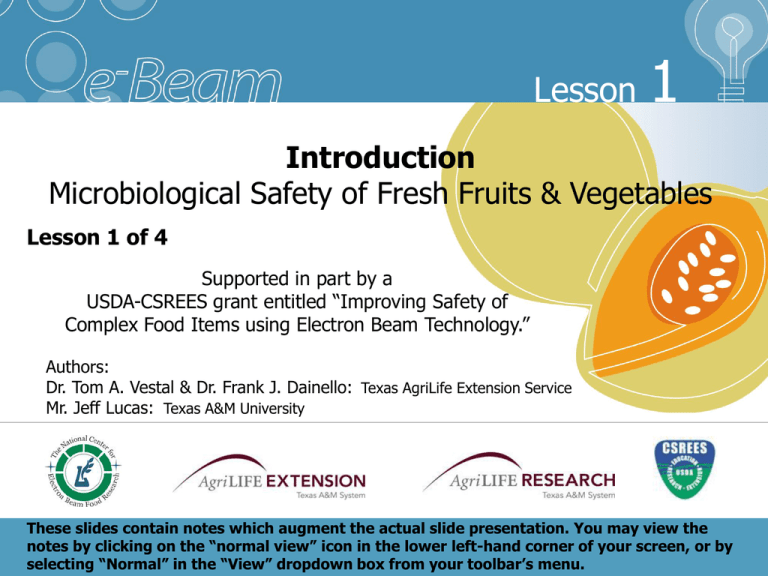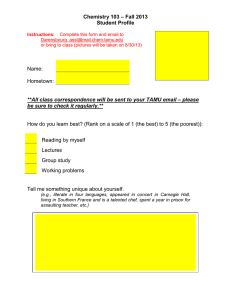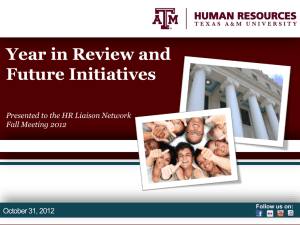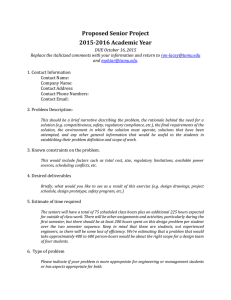1 Lesson Introduction Microbiological Safety of Fresh Fruits & Vegetables
advertisement

Lesson 1 Introduction Microbiological Safety of Fresh Fruits & Vegetables Lesson 1 of 4 Supported in part by a USDA-CSREES grant entitled “Improving Safety of Complex Food Items using Electron Beam Technology.” Authors: Dr. Tom A. Vestal & Dr. Frank J. Dainello: Texas AgriLife Extension Service Mr. Jeff Lucas: Texas A&M University These slides contain notes which augment the actual slide presentation. You may view the notes by clicking on the “normal view” icon in the lower left-hand corner of your screen, or by selecting “Normal” in the “View” dropdown box from your toolbar’s menu. Lesson 1 Objectives Consumption patterns and the increase in foodborne disease from produce. Define foodborne disease. Describe foodborne infection and foodborne intoxication. Identify causes of foodborne disease outbreaks. Identify agents of foodborne disease. www.tamu.edu/ebeam Lesson 1 Per capita (lb) consumption of raw fruits & vegetables in the U.S. (USDA 1999). 1982 1983 1984 1985 1986 1987 Vegetables Fruits 1988 0 20 40 60 80 100 120 140 160 FDA, Outbreaks Associated with Fresh Produce, Table lV-2., 2001. Reminder: To view the notes, from the toolbar click “View” www.tamu.edu/ebeam then from the dropdown box which appears click “Normal”. Lesson 1 Average Servings Consumed Year Fruit Vegetables 1989-1991 1.3 3.2 1994-1996 1.5 3.4 U.S. GAS, Fruits and Vegetables: Enhanced Federal Efforts to Increased Consumption. 2002 www.tamu.edu/ebeam Lesson 1 Average Servings Consumed 1994 1996 1998 2000 Total Servings Fruit & Vegetables 3.44 3.43 3.38 3.37 Total Servings Vegetables 2.06 2.05 2.02 2.02 Total Servings Fruits 1.05 1.05 1.04 1.00 U.S. GAS, Fruits and Vegetables: Enhanced Federal Efforts to Increased Consumption. 2002 www.tamu.edu/ebeam Lesson 1 Increased Consumption of Fresh Produce and the Occurrence of Foodborne Disease “During the last three decades, the number of outbreaks caused by foodborne pathogens associated with fresh produce consumption reported to the Centers for Disease Control and Prevention has increased.” Sivapalasingam et al., Journal of Food Protection., Vol 67, No. 10, 2004, pp 2342-2353 www.tamu.edu/ebeam 1973 – 1997 Produce-associated foodborne illness data… Produce-Associated Foodborne Illness Data Outbreaks Hospitalizations Illnesses Deaths 1973 - 1997 190 598 16,058 8 Lesson 1 Produce of greatest risk… Salad Lettuce Juice Melon Produce as a % of all outbreaks Sprouts 0.7% in the 1970s 12% in the 1990s Berries Sivapalasingam et al., Journal of Food Protection., Vol 67, No. 10, 2004, pp 2342-2353 www.tamu.edu/ebeam Lesson 1 Factors Affecting an Increase in Foodborne Illness Related to Fresh Fruits & Vegetables. Increased consumption of raw fruits & vegetables. Greater consumption of foods not prepared in the home. Increase in popularity of salad bars (buffets). Greater volumes of both intact and prepared fruits & vegetables. Shipments from centralized locations. Distributions over a wider geographical area. Increased global trade. FDA, Outbreaks Associated with Fresh Produce, 2001 www.tamu.edu/ebeam Lesson 1 Foodborne Disease Sometimes referred to as food poisoning. An illness contracted through the consumption of contaminated food stuffs containing agent(s) that cause an adverse health reaction. www.tamu.edu/ebeam Lesson 1 Growing Hazards Soil borne microbes Contaminated soil or irrigation water Wildlife and bird feces Improperly composted manures www.tamu.edu/ebeam Lesson 1 Harvesting Hazards Poor personal hygiene Human contamination (lack of or inadequate toilet and hand washing facilities) Unclean harvesting containers and equipment Metal and lubricant contamination from harvesting equipment www.tamu.edu/ebeam Lesson 1 Processing Hazards Cross contamination of microbes Appropriate temperature Metal and lubricant contamination from processing equipment Human contamination Failure to adequately clean and sanitize processing equipment at proper intervals Use of unapproved and/or non-potable water supply Proper pest and animal control practices and equipment Not using sanitized storage, processing, and shipping containers www.tamu.edu/ebeam Lesson 1 Storage and Distribution Hazards Temperature conducive to microbe population growth Transportation equipment contaminated by previous cargo Incidental lapses in pest and animal control effectiveness www.tamu.edu/ebeam Lesson 1 Preparation Hazards Kitchen surface contamination Improper washing of hands and produce Utensil cross contamination Lack of proper temperature control Contamination from other meal items such as raw meat Improper cooking www.tamu.edu/ebeam Lesson 1 Foodborne Infection A foodborne disease caused by the consumption of contaminated foods containing live microorganisms or the spores of those microorganisms. Growth and multiplication of the microbes or spores must occur in order to cause disease. Most bacterial pathogens double in population every 20 minutes. www.tamu.edu/ebeam Lesson 1 Foodborne Intoxication A foodborne disease caused by the consumption of contaminated foods containing a chemical agent or toxin as a by-product of microbial growth. Consumption of live microorganisms is not required. An example of an intoxicant is Clostridium botulium, found in soil, affects the nervous system and has been found in improperly processed canned foods, potatoes, olives, spinach, garlic, mushrooms, beets, asparagus, peppers, beans, and eggplant. www.tamu.edu/ebeam Lesson 1 Agents of Foodborne Disease Bacterial Viral Parasitic Chemical www.tamu.edu/ebeam Lesson 1 Examples of Microbiological Agents (Pathogens) of Foodborne Disease Listeria monocytogenes Salmonella Escherichia coil 0157:H7 Shigella spp. Clostridium botulinum Bacterial Hepatitis A noroviruses Viral Giardia Cyclospora Cryptosporidium Parasitic Food Safety Guidelines for the Fresh-cut Produce Industry 4th Ed, IFPA., 2001., P. 17 www.tamu.edu/ebeam Lesson 1 Symptoms of Disease Foodborne Disease of Bacterial Origin Acute upper GI nausea, vomiting 1 – 6 hours Preformed heat stable toxins of S. aureus and B. cereus. Upper small bowel, watery diarrhea 6 – 72 hours C. perfringens, V. cholerae, B. cereus (diarrheal), enterotoxigenic E. coli. Inflamed lower intestine (inflammatory ileocolitis) 16 – 72 hours Salmonella, Shigella, C. jejuni, V. parahaemolyticus, Yersinia, enteroinvasive E. coli. Sensory or motor neurologic, with or without diarrhea 1 – 4 days C. botulinum toxin www.tamu.edu/ebeam Lesson 1 Pathogens & Spoilage Organisms Disease: Pathogens: Microorganisms that cause disease. Spoilage Organisms: Microorganisms that through growth render food stuffs unsuitable for consumption due to changes in odor, flavor, color consistencies or visible presence. www.tamu.edu/ebeam Lesson 1 Common Spoilage Organisms Organism Product Source Pseudomonas species Vegetables Soil, plant material Lactic Acid Bacteria Vegetables Soil Molds Fruits and vegetables Soil, plant materials Yeasts Fruits Soil Food Safety Guidelines for the Fresh-cut Produce Industry 4th Ed, IFPA., 2001., P. 17 www.tamu.edu/ebeam Lesson 1 References International Fresh-cut Produce Association. 2001. Food Safety Guidelines for the Freshcut Produce Association. 4th. Edition. Serdula M, Gillespie C, Kettel-Khan L, Farris R, Seymour J, Denny C. Trends in Fruit and Vegetable Consumption Among Adults in the United States: Behavioral Risk Factor Surveillance System, 1994-2000. American Journal of Public Health. June 2004. Vol 94, No 6. Silliker, Inc. 2003. Principles of Food Microbiology Short Course. Huntington Beach, CA. March, 2003. Sivapalasingam S, Friedman C, Cohen L, Tauxe R. Fresh Produce: A Growing Cause of Outbreaks of Foodborne Illness in the United States, 1973 through 1997. Journal of Food Protection. 2004. Vol 67. No 10. Pp. 2342-2353. U.S. Food and Drug Administration. CFSAN. 2001. Analysis and Evaluation of Preventive Control Measures for the Control and Reduction/Elimination of Microbial Hazards on Fresh and Fresh-Cut Produce. Food and Drug Administration (FDA), Washington, D.C. U.S. General Accounting Office. 2002. Fruits and Vegetables: Enhanced Federal Efforts to Increase Consumption Could Yield Health Benefits for Americans. General Accounting Office (GAO), Washington, D.C. www.tamu.edu/ebeam Module 1 www.tamu.edu/ebeam



